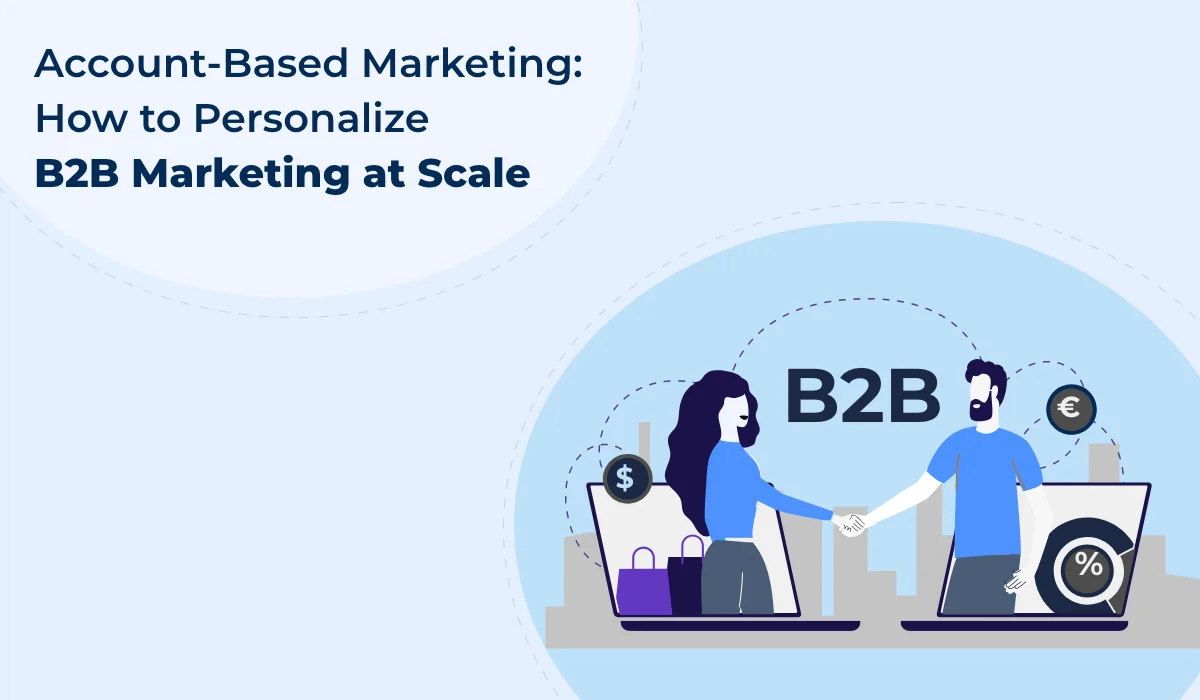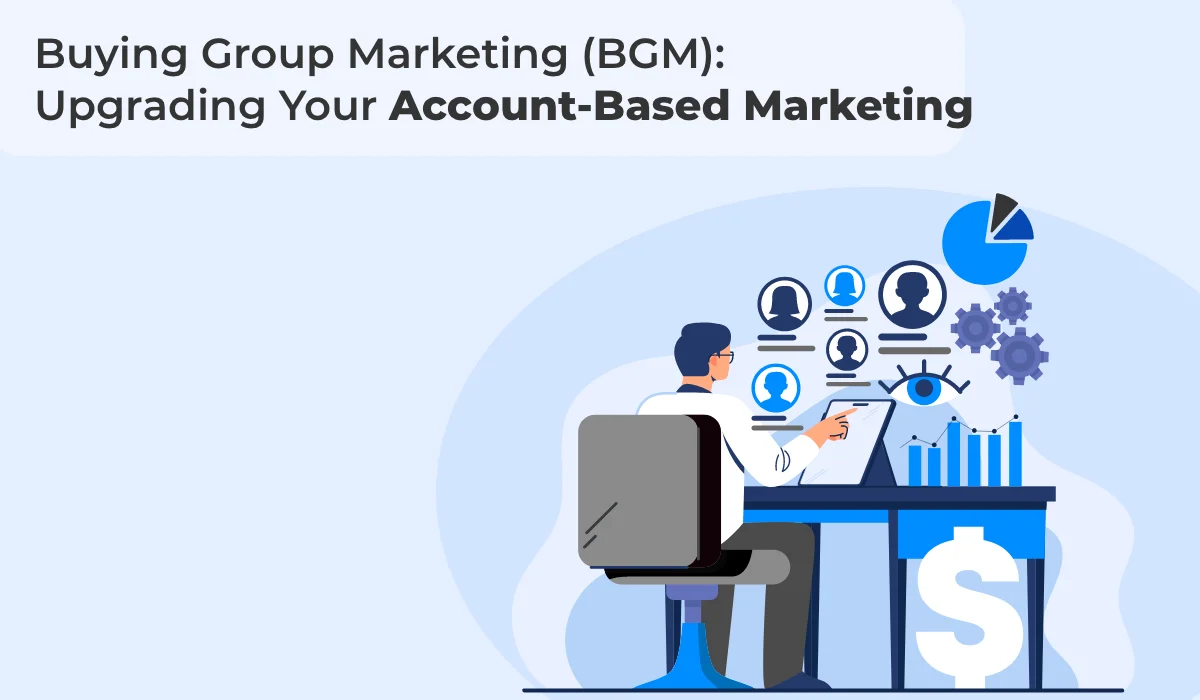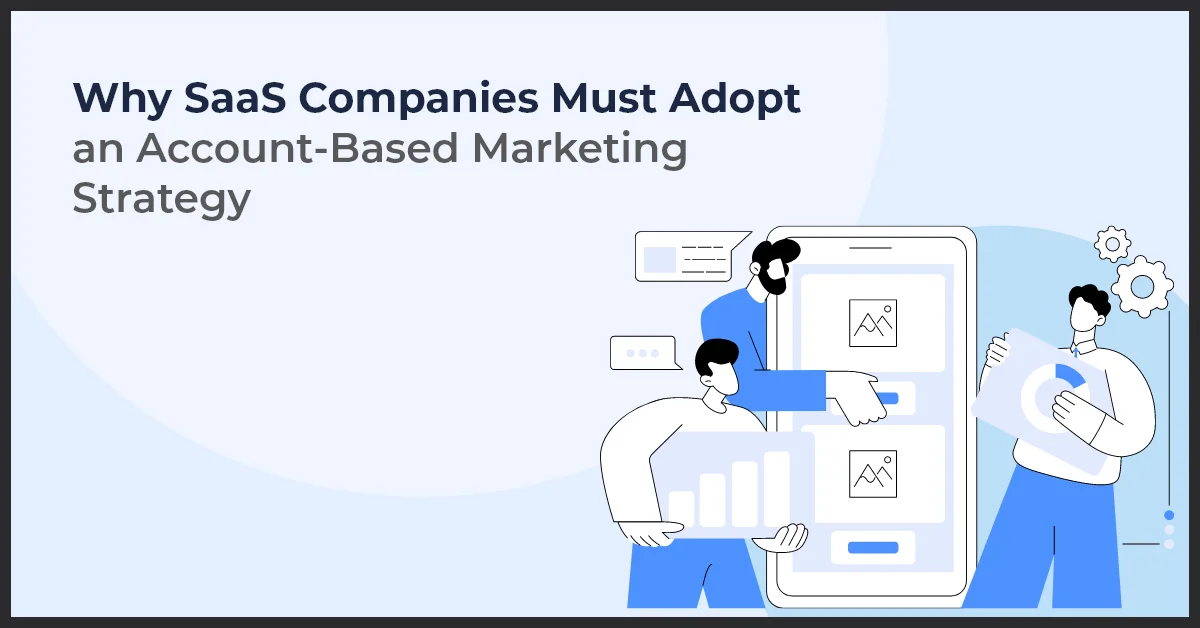B2B Moving Toward ABM: Boosting ROI and Personalization

Published on: February 14, 2022
Updated on: March 28, 2025
1946 Views
- Account Based Marketing
9 min read
A report from MarketingProfs shows a 208% increase in revenue of companies using ABM. Another report from ABM Leadership Alliance represents a 171% surge in average annual contracts. Another interesting statistic from Gartner shows a 70% boost in opportunities produced through ABM.
The numbers don’t lie! Account-based marketing (ABM) has seen significant growth in the B2B sector in a short time. Marketers are increasingly turning to account-based marketing to discover, engage, and nurture leads.
So, what is it that makes ABM a huge popularity among B2B marketers? It’s the advancements made in the accessibility of relevant data and the technologies it uses.
ABM is not a new technology; it has been used by marketers for years. Account-based marketing (ABM) tools automate data and workflow processes, thus helping B2B marketers make informed decisions.
In order to meet the vision of quality outreach, organizations can create highly customized and consistent strategies with ABM to build and improve relationships with clients.
ABM complements B2B marketing goals, which is why there is a huge shift in this sector. In this article, we will cover the role of ABM in B2B marketing as well as how to run an effective ABM campaign.
Stay tuned!
Why Does ABM Play a Vital Role in B2B Marketing?
The wonderful thing about account-based marketing (ABM) is that it tackles problems throughout the customer journey. ABM has made it to B2B marketing strategies for a myriad of reasons, and some of them are mentioned below:
1. Collaborative Process
ABM bridges any gaps between your sales and marketing teams, thus letting them work together to implement marketing initiatives strategically and successfully.
2. Focused Strategy
ABM allows both your marketing and sales teams to create strategies that let them focus on more targeted and loyal accounts.
3. Increased Engagement
ABM lets the targeted accounts engage earlier in the sales cycle which results in invaluable opportunities for your business growth.
How Does Account-Based Marketing Work?
Identify Companies You Want to Target
Your first step should be to determine who your target company is before you begin developing a plan. Begin by looking at who is visiting your website using a visitor identification tool; it will help you discover who is interested in your solution.
Then, for potential prospects, look at the marketing tools you are already using, such as your email list and CRM. Next, actively look for companies in your target market. For instance, if you're looking for a software marketing business, you can search for "top software companies," which will provide you with a list of potential companies.
Concentrate your efforts on high-value businesses that are well-suited to the ABM strategy.
Tier the Data
After you've compiled a list of possibilities, it's time to begin tiering them. To get your target audience’s contact information, use LinkedIn or the company's website. The goal here is to understand who can be the best fit for your targeting efforts, whether it is the VP of the company or the marketing head.
Remember, the CEO is unlikely to be a good target; the marketing director or HR executive assistant can be ideal. Once you have gathered the information, it’s time to toss all of this information into a spreadsheet, including names, email addresses, and queries (they've asked in online groups or on LinkedIn).
Create an Ideal Customer Profile
Account-based Marketing is a selective approach; you need to be thorough when it comes to targeting companies.
As ABM revolves around who you want to target, it is important to select companies that can benefit from your services. Furthermore, ABM makes them your top-tier companies once you convert them into clients.
Create Content for Your Target Audience
It's time to court your leads now that you know who they are. Creating tailored content, be it in the form of blog entries, emails, adverts, or white papers, is the core of account-based marketing (ABM).
The main goal is to solve the difficulties that a particular organization is facing or a specific roadblock in its conversion process.
Make sure the excellent content you own reaches the appropriate people. Begin by establishing campaigns for each tier and persona, then tailor your strategy to each channel and tier.
Running an Effective B2B ABM Campaign
Determine Your End Goals
You can't know what ideas will actually benefit your organization or marketing initiatives until you have a clear vision of success. As a business, you must decide what you want to achieve, which is why you need to define your company goals by asking yourself the following questions:
- What problems can this service solve?
- Which companies struggle with this problem?
- Why do you need to resolve this issue?
- How to reach companies facing this problem?
This is not a complete and thorough list, but it helps you to understand what your goals are and what is the purpose behind the targeting. Once you understand the basis of your marketing, you can drill down the questions to who and how to serve.
The idea is to ask questions that will allow you to acquire qualitative information about your company. When you have a good understanding of the characteristics of consumers, you can start collecting data that shows you are accomplishing your goal.
Identify Your ABM Strategy
After you've gone over these questions and set your company goals, you'll need to devise a strategy to achieve them. When it comes to the distinctions between goals, strategies, and tactics, many firms are in a dilemma.
- Your business goals are the directions you wish to take it.
- The strategy you devise to get there is the plan you need.
- The way to get there is via tactics.
Take a look at your company's objectives. Determine whether an ABM approach might help you reach your objectives. Take a look at what you're good at. Then check to see whether there are any market gaps. Growth Native’s guide on 6 Account-Based Marketing Strategies will help you formulate the right ABM strategy.
Build Targeted Account List
Any marketing effort should begin with figuring out who you are aiming to target. You will need to construct a target account list once you have decided on your ABM approach. In order to create the targeted account list, follow the below-mentioned steps.
- Create an ideal customer persona
- Create a target list based on customer persona
- Understand the needs of accounts on the list
- Create a tiered approach with data collected
Align Your Marketing and Sales Teams to Generate Revenue
When marketing and sales take charge of revenue, they also take charge of their part in the company's success. When your income rises, your consumers are telling you that you have achieved your goal. You are assisting them in overcoming their difficulties, and they require your assistance in order to complete their mission. Increasing revenue is the most obvious sign that a company is succeeding. You need to know:
- If your marketing campaigns only generate traffic and views but no revenue
- If your sales are talking more about closing deals, call volume than increasing revenue
Both marketing and sales are unlikely to gauge their performance in terms of money. When you set a revenue objective for your marketing and sales teams to meet, you will notice that they begin to communicate and align more organically.
Evaluate Your Tactics
Many companies place a high value on attending trade shows. In certain businesses, field salespeople visit a specified number of accounts in person. There are a few things to keep in mind regardless of the strategy you pick.
- Focus on adding value
- Reach out to the decision-makers
- Invest in the right marketing strategies and efforts
Your company can have various tactics that your target accounts will prefer. Thus, you need to ensure that any strategies you employ reach decision-makers, provide value, and lead back to a marketing channel that you control.
Develop Personalized Content
By now you have generated a target account list, an ABM strategy, and deployed the appropriate tactics for your approach. Now, it is time to get in action. To reach your customers, you need content, ideas, and concepts that provide value to your end accounts. ABM is a smart strategy; it works well when you personalize content.
Using the same and monotonous material will not attract your clients. You need to be more creative in crafting content, and personalization is the best way to initiate this process. In order to develop personalized content, you need to understand your customers, and once you have acquired the level of understanding, you can come out with content that benefits both you and your targeted accounts.
Here are the types of content that you can use to run the most successful ABM campaigns:
- Emails to each account
- Landing page content to facilitating form filling
- Thought leadership through blogs and articles to generate awareness
- Product-specific pages that narrate prices and versions
- Customer testimonials to increase acquisition and retention
The purpose of your content is to develop something which makes a small group of high-value customers feels understood and as if their future success is dependent on a discussion with your brand. As a result, develop content that provides clients with value and generates income for your company.
Final Thoughts
If you are like many other businesses that began with a great concept and have probably never looked back, then ABM gives you the chance to create the type of business you want to run and succeed.
Account-based marketing (ABM) has been demonstrated to perform extremely successfully for B2B organizations. If not strategized properly, it can bring various obstacles, though it's still well worth the effort.
If you have any questions, observations, or examples of what's working and what's not in Account-based marketing (ABM), then contact us at info@growthnatives.com and we'll make sure they are addressed!
Frequently Asked Questions
B2B advertisers should consider Account-Based Marketing (ABM) because it allows them to focus their resources and efforts on high-value accounts that are more likely to convert. ABM helps personalize marketing messages and strategies for specific accounts, leading to higher engagement and ROI.
ABM, or Account-Based Marketing, is a strategic approach to B2B marketing where businesses target and tailor their marketing efforts towards specific accounts or companies rather than targeting a broader audience. ABM involves identifying key accounts, understanding their needs, and creating personalized marketing campaigns to engage and convert them.
ABM differs from other B2B strategies, such as inbound marketing or traditional lead generation, in that it is highly targeted and personalized. While other strategies may focus on attracting a larger audience and nurturing leads over time, ABM focuses on building relationships with specific high-value accounts from the outset.
Businesses choose account-based marketing (ABM) because it offers several advantages, including:
- Higher ROI: ABM allows businesses to focus their resources on accounts that are more likely to convert, leading to a higher return on investment.
- Better alignment with sales: ABM helps align marketing and sales efforts towards common goals, leading to more effective collaboration and improved sales outcomes.
- Personalized approach: ABM allows businesses to tailor their marketing messages and strategies to specific accounts, increasing the likelihood of engagement and conversion.
- Improved customer relationships: By focusing on building relationships with key accounts, ABM helps businesses deepen their connections and loyalty with customers.



